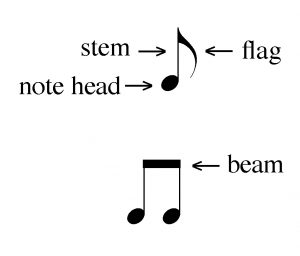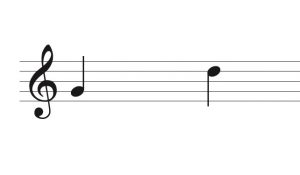2 Notes and Clefs
When naming and identifying notes on a staff, it is important to recognize that the clef is what determines where notes are placed on the staff. Notes are named based on their placement on the staff using the musical alphabet: A, B, C, D, E, F, and G.
Click through the following slides to learn more. If you see a blue information icon, click to read for more information. You can also click the icon at the bottom right to view it in full-screen mode.
Exercise
Notes written on the staff always consist of a note head and often have a stem and sometimes even a flag or beam.

Flags are added to notes to indicate how long or short a note is to be played (see Chapter III). Stems can point both up or down. Notes that are below the centre line have their stem on the right-hand side of the note head and point up, whereas notes above the centre line have their stem on the left-hand side and point down.

Exercises

